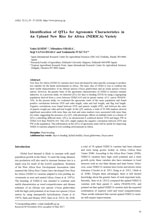New Rice for Africa (NERICA) varieties have been developed by inter-specific crossings to produce rice suitable for the harsh environments in Africa. The basic idea of NERICA was to combine the most useful characteristics of an African species (Oryza glaberrima) and an Asian species (Oryza sativa). However, the genetic basis of the agronomic characteristics of NERICA varieties remains unknown. In a previous study, we detected QTLs for days to heading (DTH) by using a segregating population derived from a cross between NERICA10 and its parent variety of O. sativa (WAB56- 104). In the present study, we evaluated the agronomic traits of the same population and found positive correlations between DTH and culm length, culm and leaf weight, and flag leaf length. Negative correlations were found between DTH and panicle weight (PW), and between the ratio of panicle weight per culm and leaf weight. In the QTL analysis, a total of 33 SSR markers showed significant association with more than one trait and some markers were associated with more than two traits, suggesting the presence of a QTL with pleiotropic effects on multiple traits or a cluster of QTLs controlling different traits. QTLs on chromosome 8 conferred shorter DTH and larger PW in NERICA10 than WAB56-104. This QTL might explain the negative correlation between DTH and PW in the population. This information on the QTLs of agronomic traits will be useful for improving NERICA varieties adapted to low-yielding environments in Africa.

